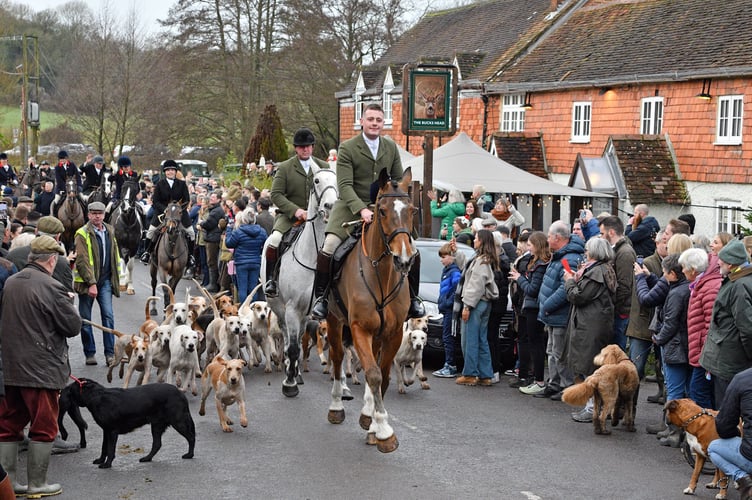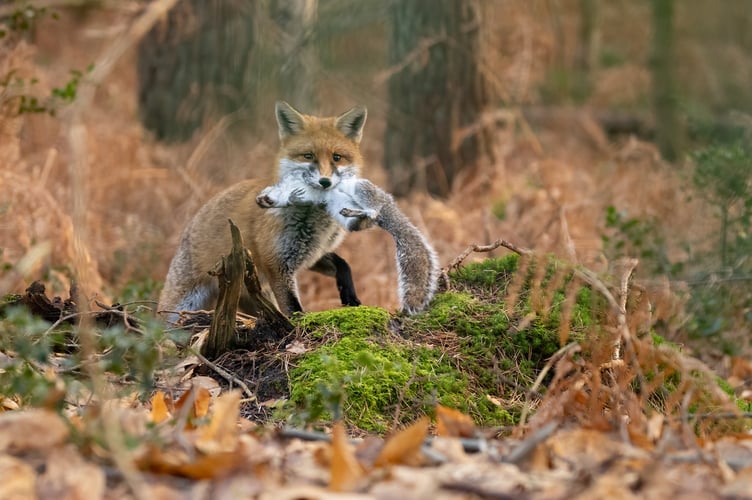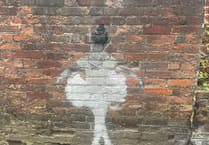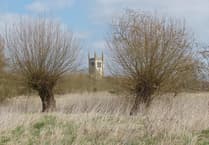A picture that is sure to divide opinion among readers in today's Peeps into the Past - but no less historical for its controversy, having been a feature of the Hampshire countryside for almost 300 years.
The Hampshire Hunt, seen here moving off from a meet in Blackmoor in 1949, is a tradition that has operated continuously in the county since 1749, making it one of the oldest hunts in England.
The group was forced to leave the bloodsport of fox hunting behind with the passing of the 2004 Hunting Act, and today practices trail hunting - following a trail of animal urine laid in advance of the 'hunt'.
But while the sight and sounds of the hunt’s traditional scarlet and navy blue blazers, immaculately groomed mounts, baying hounds and rallying horns have been preserved - the echoes of its bloody past sit uncomfortably with many.
The 2024 Boxing Day Hunt, for the first time in living memory, left from the centre of Alresford, and Winchester City Council’s decision to grant a road closure in Station Road attracted criticism from anti-hunt protesters in October.
Although many townsfolk poured into the town to enjoy the spectacle, inevitably there were also hunt saboteurs and monitors, with an active anti-hunt community keeping close tabs on Hampshire Hunt’s activities over the years.

The controversial practice is, however, steeped in history.
The ancient Egyptians are believed to have been the first to use dogs to hunt foxes, which have long been considered vermin in farming communities.
However, it wasn’t until the 18th century that the practice was considered a sport in its own right in Britain.
Locally, the Hampshire Hunt grew out of gentlemen’s dining club ‘The HH Society’ in the mid-18th century, whose members enjoyed various entertainments and pursuits, including hunting. Its founder and first Master was Thomas Ridge, an influential Hampshire landowner and brewer whose father had previously been MP for Poole.
Some decades later, the name was changed to ‘The Gentlemen of the Hampshire Hunt’ and members wore blue coats with large silver buttons engraved with HH. These blue coats are still worn by the hunt’s members today.

A royal seal of approval followed in 1795 when the then-HRH Prince of Wales - later to become King George IV - granted permission for members to wear the Prince of Wales' feathers embossed onto their club buttons.
Another incredible episode in the Hunt’s history followed in 1929 with the marriage of legendary Master George Evans, considered one of the greatest hound-breeders of his day, to Diana Stuart Smith at Ropley Church.
The wedding coincided with the last meet of the season, and everyone - bride, bridegroom, and some 5,000 guests - attended in hunting dress, while the happy couple arrived on horse-back.
The Hampshire Telegraph of April 26, 1929, recounted: “Scarlet-coated members of the Hampshire Hunt formed an archway of riding crops as Mr and Mrs Evans walked from the church, and when the bridegroom reached the gate, he was presented with an inscribed hunting horn.”
A reception was held at nearby Hall Place, attended by founder of the Boy Scouts’ movement Sir Robert Baden Powell, before the bride and bridegroom led the party on its final hunt of the season.
The couple did not live happily ever after, however, as just a year later and after a short illness the bride, Mrs Diana Evans, died. George and Diana are remembered on a gravestone in Ropley churchyard to this day.
The biggest day in the hunt’s annual calendar is, like hundreds of hunts across the country, its Boxing Day meet.
After appearances at the Butts in Alton and Shalden in recent years, this year’s hunt left Station Road in New Alresford at 11am on Boxing Day.
Whether you think this adds to the festivities or detracts from them, the event is sure to spark lively debate, drawing both supporters who cherish its tradition and critics who condemn its legacy.


-Cllr-Lulu-Bowerman-Tim-Lawton--Image-LDRs.jpeg?width=209&height=140&crop=209:145,smart&quality=75)



.png?width=209&height=140&crop=209:145,smart&quality=75)
Comments
This article has no comments yet. Be the first to leave a comment.